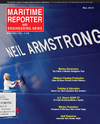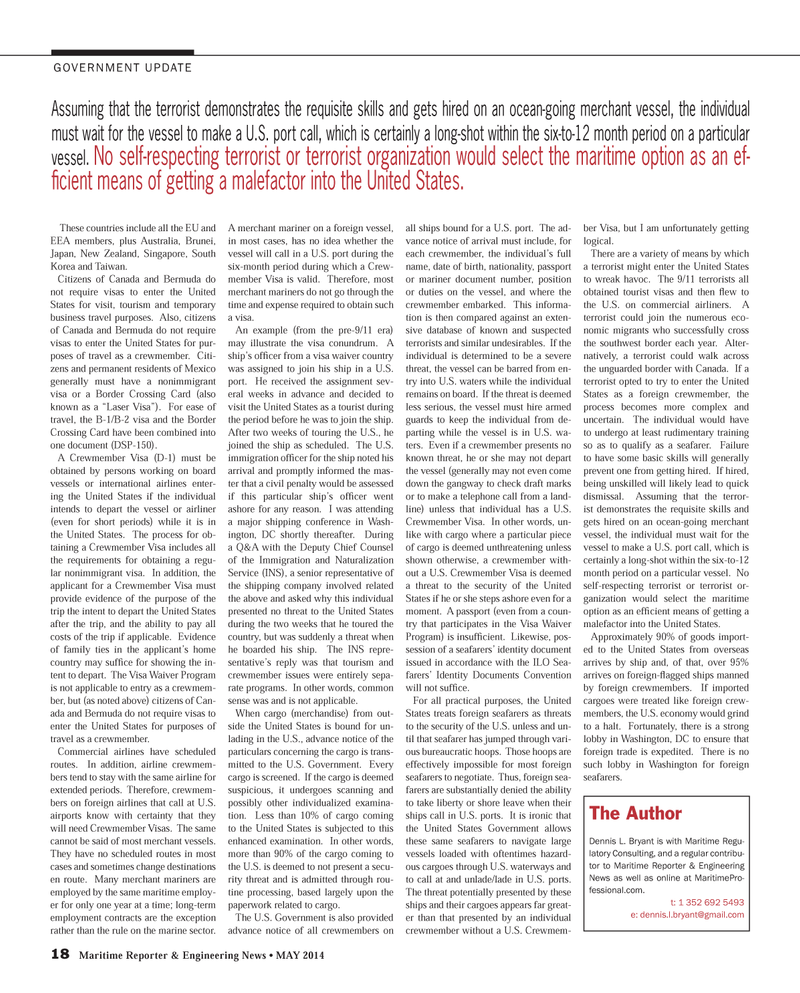
Page 18: of Maritime Reporter Magazine (May 2014)
Marine Electronics Edition
Read this page in Pdf, Flash or Html5 edition of May 2014 Maritime Reporter Magazine
18 Maritime Reporter & Engineering News • MAY 2014
GOVERNMENT UPDATE These countries include all the EU and
EEA members, plus Australia, Brunei,
Japan, New Zealand, Singapore, South
Korea and Taiwan.
Citizens of Canada and Bermuda do not require visas to enter the United
States for visit, tourism and temporary business travel purposes. Also, citizens of Canada and Bermuda do not require visas to enter the United States for pur- poses of travel as a crewmember. Citi- zens and permanent residents of Mexico generally must have a nonimmigrant visa or a Border Crossing Card (also known as a “Laser Visa”). For ease of travel, the B-1/B-2 visa and the Border
Crossing Card have been combined into one document (DSP-150).
A Crewmember Visa (D-1) must be obtained by persons working on board vessels or international airlines enter- ing the United States if the individual intends to depart the vessel or airliner (even for short periods) while it is in the United States. The process for ob- taining a Crewmember Visa includes all the requirements for obtaining a regu- lar nonimmigrant visa. In addition, the applicant for a Crewmember Visa must provide evidence of the purpose of the trip the intent to depart the United States after the trip, and the ability to pay all costs of the trip if applicable. Evidence of family ties in the applicant’s home country may suffi ce for showing the in- tent to depart. The Visa Waiver Program is not applicable to entry as a crewmem- ber, but (as noted above) citizens of Can- ada and Bermuda do not require visas to enter the United States for purposes of travel as a crewmember.
Commercial airlines have scheduled routes. In addition, airline crewmem- bers tend to stay with the same airline for extended periods. Therefore, crewmem- bers on foreign airlines that call at U.S. airports know with certainty that they will need Crewmember Visas. The same cannot be said of most merchant vessels.
They have no scheduled routes in most cases and sometimes change destinations en route. Many merchant mariners are employed by the same maritime employ- er for only one year at a time; long-term employment contracts are the exception rather than the rule on the marine sector.
A merchant mariner on a foreign vessel, in most cases, has no idea whether the vessel will call in a U.S. port during the six-month period during which a Crew- member Visa is valid. Therefore, most merchant mariners do not go through the time and expense required to obtain such a visa.
An example (from the pre-9/11 era) may illustrate the visa conundrum. A ship’s offi cer from a visa waiver country was assigned to join his ship in a U.S. port. He received the assignment sev- eral weeks in advance and decided to visit the United States as a tourist during the period before he was to join the ship.
After two weeks of touring the U.S., he joined the ship as scheduled. The U.S. immigration offi cer for the ship noted his arrival and promptly informed the mas- ter that a civil penalty would be assessed if this particular ship’s offi cer went ashore for any reason. I was attending a major shipping conference in Wash- ington, DC shortly thereafter. During a Q&A with the Deputy Chief Counsel of the Immigration and Naturalization
Service (INS), a senior representative of the shipping company involved related the above and asked why this individual presented no threat to the United States during the two weeks that he toured the country, but was suddenly a threat when he boarded his ship. The INS repre- sentative’s reply was that tourism and crewmember issues were entirely sepa- rate programs. In other words, common sense was and is not applicable.
When cargo (merchandise) from out- side the United States is bound for un- lading in the U.S., advance notice of the particulars concerning the cargo is trans- mitted to the U.S. Government. Every cargo is screened. If the cargo is deemed suspicious, it undergoes scanning and possibly other individualized examina- tion. Less than 10% of cargo coming to the United States is subjected to this enhanced examination. In other words, more than 90% of the cargo coming to the U.S. is deemed to not present a secu- rity threat and is admitted through rou- tine processing, based largely upon the paperwork related to cargo.
The U.S. Government is also provided advance notice of all crewmembers on all ships bound for a U.S. port. The ad- vance notice of arrival must include, for each crewmember, the individual’s full name, date of birth, nationality, passport or mariner document number, position or duties on the vessel, and where the crewmember embarked. This informa- tion is then compared against an exten- sive database of known and suspected terrorists and similar undesirables. If the individual is determined to be a severe threat, the vessel can be barred from en- try into U.S. waters while the individual remains on board. If the threat is deemed less serious, the vessel must hire armed guards to keep the individual from de- parting while the vessel is in U.S. wa- ters. Even if a crewmember presents no known threat, he or she may not depart the vessel (generally may not even come down the gangway to check draft marks or to make a telephone call from a land- line) unless that individual has a U.S.
Crewmember Visa. In other words, un- like with cargo where a particular piece of cargo is deemed unthreatening unless shown otherwise, a crewmember with- out a U.S. Crewmember Visa is deemed a threat to the security of the United
States if he or she steps ashore even for a moment. A passport (even from a coun- try that participates in the Visa Waiver
Program) is insuffi cient. Likewise, pos- session of a seafarers’ identity document issued in accordance with the ILO Sea- farers’ Identity Documents Convention will not suffi ce.
For all practical purposes, the United
States treats foreign seafarers as threats to the security of the U.S. unless and un- til that seafarer has jumped through vari- ous bureaucratic hoops. Those hoops are effectively impossible for most foreign seafarers to negotiate. Thus, foreign sea- farers are substantially denied the ability to take liberty or shore leave when their ships call in U.S. ports. It is ironic that the United States Government allows these same seafarers to navigate large vessels loaded with oftentimes hazard- ous cargoes through U.S. waterways and to call at and unlade/lade in U.S. ports.
The threat potentially presented by these ships and their cargoes appears far great- er than that presented by an individual crewmember without a U.S. Crewmem- ber Visa, but I am unfortunately getting logical.
There are a variety of means by which a terrorist might enter the United States to wreak havoc. The 9/11 terrorists all obtained tourist visas and then fl ew to the U.S. on commercial airliners. A terrorist could join the numerous eco- nomic migrants who successfully cross the southwest border each year. Alter- natively, a terrorist could walk across the unguarded border with Canada. If a terrorist opted to try to enter the United
States as a foreign crewmember, the process becomes more complex and uncertain. The individual would have to undergo at least rudimentary training so as to qualify as a seafarer. Failure to have some basic skills will generally prevent one from getting hired. If hired, being unskilled will likely lead to quick dismissal. Assuming that the terror- ist demonstrates the requisite skills and gets hired on an ocean-going merchant vessel, the individual must wait for the vessel to make a U.S. port call, which is certainly a long-shot within the six-to-12 month period on a particular vessel. No self-respecting terrorist or terrorist or- ganization would select the maritime option as an effi cient means of getting a malefactor into the United States.
Approximately 90% of goods import- ed to the United States from overseas arrives by ship and, of that, over 95% arrives on foreign-fl agged ships manned by foreign crewmembers. If imported cargoes were treated like foreign crew- members, the U.S. economy would grind to a halt. Fortunately, there is a strong lobby in Washington, DC to ensure that foreign trade is expedited. There is no such lobby in Washington for foreign seafarers.
The Author
Dennis L. Bryant is with Maritime Regu- latory Consulting, and a regular contribu- tor to Maritime Reporter & Engineering
News as well as online at MaritimePro- fessional.com. t: 1 352 692 5493 e: dennis.l.bryant@gmail.com
Assuming that the terrorist demonstrates the requisite skills and gets hired on an ocean-going merchant vessel, the individual must wait for the vessel to make a U.S. port call, which is certainly a long-shot within the six-to-12 month period on a particular vessel. No self-respecting terrorist or terrorist organization would select the maritime option as an ef- fi cient means of getting a malefactor into the United States.
MR #5 (18-25).indd 18 4/30/2014 2:29:01 PM

 17
17

 19
19
